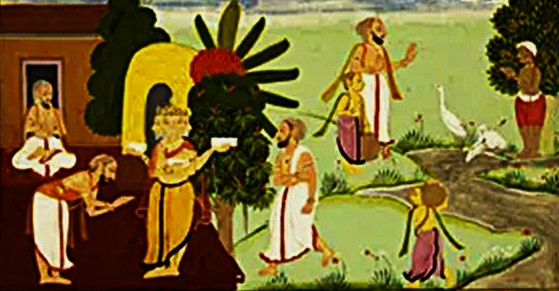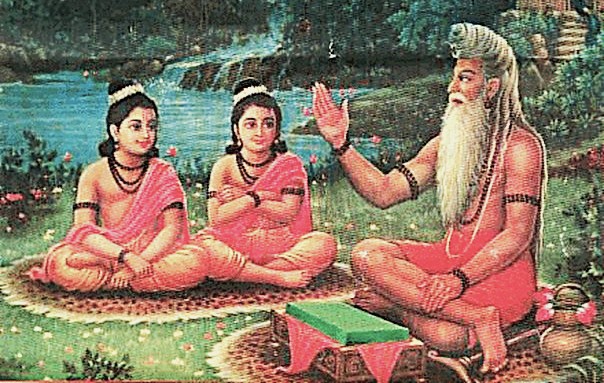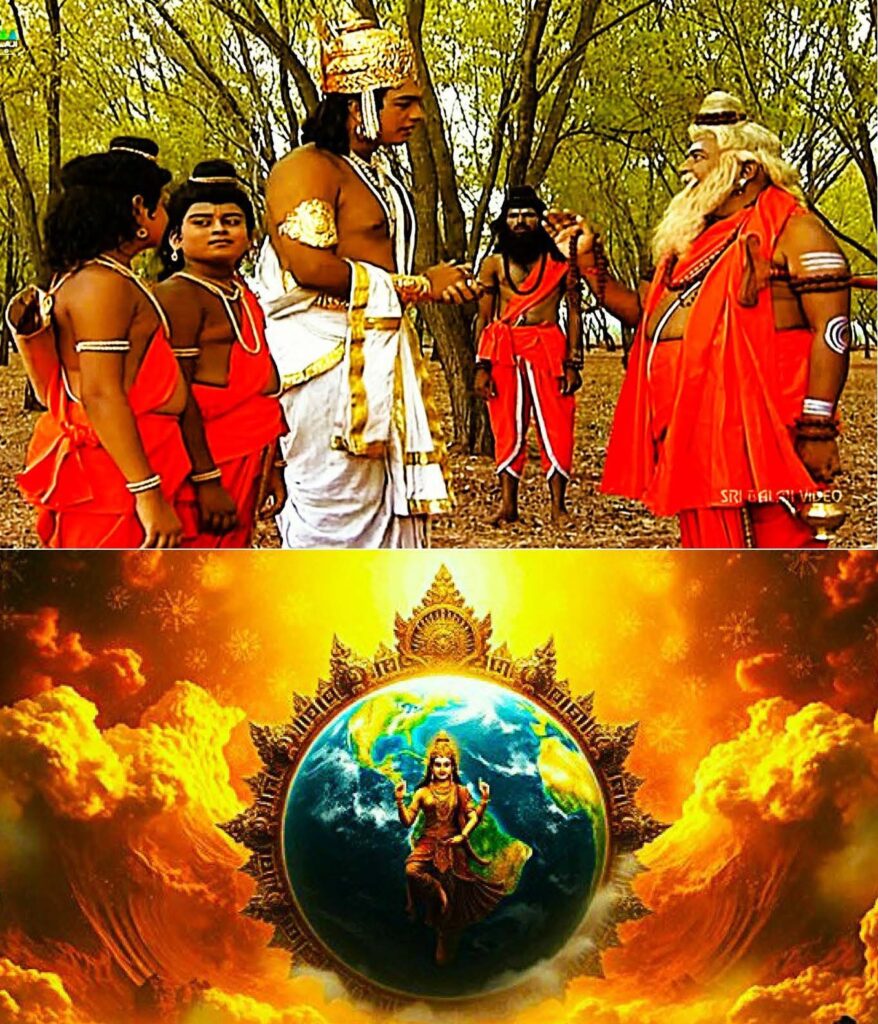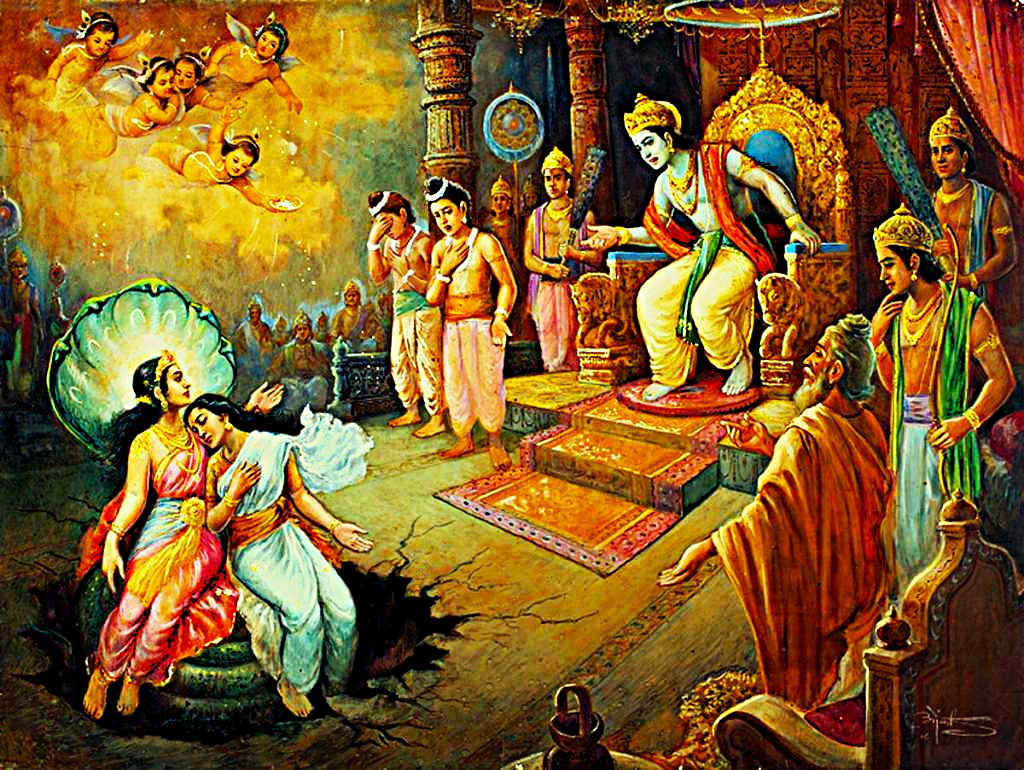Philosophy of Peace in the Life of Maharishi Valmiki–The Sage from the Anthill to Spiritual Metamorphosis
TRANSCEND MEMBERS, 3 Nov 2025
Prof Hoosen Vawda – TRANSCEND Media Service
This publication is suitable for general readership. Parental guidance is recommended for minors who may use this paper as a resource material, for projects.
***********************
The author, a Muslim, unconditionally apologises for any misrepresentations or misconceptions expressed about religious beliefs in Hinduism and cultural practises, as stated in this publication. The paper is based on the author’s extensive research, appended with online references, as well as discourse with my interfaith associates, in good faith. If any reader finds any statements recorded, as objectionable, you are kindly invited to correspond with the author, by the listed e-mail or global voice contact.
” Maharishi Valmiki’s greatness stems from a different, equally powerful source: his own spiritual transformation (sadhana) from a fallen state of a criminal, to the highest state of enlightenment. He is a Swayambhu (self-manifested) sage in the sense that he achieved his status through his own efforts, not by being born, as a pre-ordained divine incarnation.”[1]

Sage Maharishi Valmiki, the author of the great scriptural epic in Hinduism, in a study, showing him deeply engrossed in physically writing the original Ramayana in 3rd century BCE, seated under a tree compiling the tome as a guide for all of humanity,
Photo Credit: Mrs V. Vawda
Prologue
In this publication, the author presents the life of Sage Maharishi Valmiki highlighting his transformation from a hunter to a sage. Therein lies the physical inspiration for all of humanity, to transform their reptilian and limbic functionality nervous systems, to be converted into a human practising and demonstrating the functionality of the higher mental expression, as a better human, to espouse peace, humanism and enter the realm of higher spirituality. Valmiki, who is even revered and remembered, even today in this materialistic age, as the composer of the original version of the Holy Hindu scripture, The Ramayana, as a foremost allegorical, and scriptural template for the emulation of the highest behavioural moral code of the great principals in ancient Hindu history. The author will organise the information to flow logically from biographical foundations to literary contributions, then to philosophical teachings and contemporary relevance.[2] The critical perspectives of this approach, will be important for balancing the traditional narrative, with practical relevance in the societal culture of the present era, especially for the youth to meaningfully engage with. The author commences with the famous first shloka – the “ma nishada” verse[3] – that spontaneously emerged from Valmiki’s grief upon seeing a hunter kill a mating bird. This is the frame, the very basic foundation of the synthesis of the human transformation; this as the moment that gave birth to poetry itself, setting the stage for his epic writing of his scriptural journey, The Ramayana. Needless to note that The Ramayana has parallels in both Abrahamic as well as Dharmic religions, globally. [4]This cannot be denied, no matter how hard the critiques of this physical, eternal and spiritual moral compass try very hard to denigrate the Holy Hindu Book, which is very much applicable in the 21st century. In fact, the tenets expressed in the book, can be used by all cultures and humans of all religious beliefs, as it is a guide, like the Islamic Quran and Hebrew Torah for all of humanity to read, follow and subscribe to the teachings in the context of various episodes, narrated in the book. It does NOT prescribe religious beliefs and practices, but a practical way of living a human life, while incorporating both traditional accounts and scholarly perspectives. The paper balances reverence for the sage with academic rigor, particularly for sections like the caste dynamics and contemporary interpretations of the holy textual contents.
The Ramayana[5] and Sage Maharishi Valmiki[6]
Valmiki, an ancient Indian sage[7] who is recognized in the Hindu tradition as the original author of the Sanskrit[8] epic the Ramayana, the story of Rama’s journey and one of the most meaningful and influential texts in Hinduism and South Asian literature. His dual role, as both the author and a character within the epic, and his foundational influence on Indian culture, spirituality, and literature. Valmiki plays a role in the epic itself by providing shelter to Rama’s wife, Sita, in his hermitage and by teaching the Ramayana to Rama and Sita’s twin sons, Kusha and Lava. He is referred to by the honorary titles Maharishi (Great Sage) and Adi Kavi (First Poet) for authoring the Ramayana. His birth anniversary, Valmiki Jayanti or Pargat Diwas[9], is celebrated on the full moon of the Hindu month of Ashvin (falling in September or October on the Gregorian calendar).
The Ramayana’s principal characters, as conceptualised by Valmiki include mortals, reincarnates, immortals, multi headed, and multi-limbed humans, divines, demons, animals, sages, kings, queens, princes, splendid palaces, inanimate entities, like Ravana’s turbo charged, flying, celestial chariot, all of which are categorised into two broad categories: The Good and The Bad. The good protagonist is represented by Lord Rama in his Cosmic Leela[10] and the Bad are led by Ravana. These can be listed as credits in a big budget, motion picture and are: –
- Rama: avatar of the Hindu god Vishnu; known for righteousness
- Sita: avatar of Vishnu’s consort, Lakshmi; known for virtue
- Lakshmana: Rama’s half-brother who accompanies him to the forest; known for loyalty
- Hanuman: monkey of divine birth; known for devotion to Rama
- Ravana: the powerful asura king of Lanka and Rama’s primary adversary
Other Key Characters
- Jatayu: vulture who tries to stop Sita’s abduction and is killed
- Nala and Nila: monkey architects of the bridge to Lanka
- Mandodari: Ravana’s pious wife, who urges him toward righteousness
- Manthara: Kaikeyi’s companion who persuades her to demand Rama’s exile
- Kausalya: Rama’s mother and King Dasharatha’s chief wife
- Jambavan: king of bears, who was created by Brahma to help Rama
- Lava and Kusha: Rama and Sita’s twin sons, born in Valmiki’s hermitage
- Shravan Kumar: boy accidentally killed by Dasharatha, who was then cursed by Shravan’s elderly parents
There are several other important figures in the vast cast of characters. Among Rama’s family and allies are
- Dasharatha: king of Ayodhya and father of Rama and his brothers
- Kaikeyi: Rama’s stepmother, who engineers his sentence of exile
- Bharat: Kaikeyi’s son who refuses kingship in favour of regency
- Sugriva: monkey king, Rama’s principal ally against Ravana
- Vibhishana: Ravana’s righteous brother who defects to Rama’s side
Antagonists include the demon princess Surpanakha, sister of Ravana; their monstrous brother Kumbhakarna, who is woken from deep slumber to be deployed against Rama’s forces; and Ravana’s powerful warrior son Meghnad, who is so formidable that he once defeated Indra, the king of the gods.
Rakshasas or Demons in the Ramayana
- Tataka: demoness who preys on sages; killed by Rama and Lakshmana
- Maricha: shape-shifts into a golden deer to help Ravana abduct Sita; killed by Rama
- Kabandha: former celestial cursed into demon form; freed by Rama and Lakshmana
- Simhika: underwater demoness; defeated by Hanuman as he flies to Lanka
- Lankini: female personification and gatekeeper of Lanka; defeated by Hanuman
- Prahasta: Ravana’s chief commander; killed by Lakshmana
- Trijata: Sita’s demoness guard, portrayed as a loyal companion
Despite being its author, Valmiki also features within the Ramayana’s main story (similar to the sage Vyasa, who both composes and plays a prominent role in the Mahabharata). The poem describes in its introductory frame narrative Valmiki’s composition of the epic text. Then in the final section of Rama’s story, the sage reappears as a part of the plot when Rama’s brother Lakshmana takes Sita to Valmiki’s hermitage. Lakshmana takes her there for shelter after Rama has banished her because he suspects her of infidelity. After Sita and Rama’s twin sons, Kusha and Lava, are born in the hermitage, Valmiki becomes their tutor and teaches them the Ramayana poem that he has composed. The epic twists around on itself when the twin boys later recount Valmiki’s poem to Rama at a sacrifice (yajna). Valmiki then appears in Rama’s court with Sita, reveals that the twin boys who have been reciting the Ramayana are indeed Rama’s sons, and vouches for Sita’s innocence.

Valmiki being inspired to write the RamayanaA painting from Udaipur of Valmiki witnessing the killing of the male krauncha bird (right) and receiving instructions from the god Brahma to write the Ramayana, 1712; in the British Library, London.
From the seeds of this first shloka, Valmiki then composed the Ramayana in the same meter after being commanded to do so by the god Brahma. The Ramayana tells the story of Rama, a prince of the Kingdom of Kosala the capital being Ayodhya.
Themes in the Valmiki’s Ramayana[11]
At its core, the Ramayana is a classic tale of the triumph of good over evil. The concepts of good and evil form two poles of a moral axis; each character in the epic moves along this axis toward one or the other pole as a result of personal decisions and actions. The complexity of choice is exemplified by Ravana, who is learned, accomplished, and devoted to the god Shiva. The Ramayana also teaches important lessons on morality and ethics. Rama, considered to be the embodiment of dharma (duty, honour, and loyalty), is regarded as the ideal son, husband, and, eventually, king.
The greatest test of his dharma comes upon his return to Ayodhya and ascent to the throne. When his subjects cast doubt on Sita’s sexual purity, Rama banishes her from the kingdom even though he knows her to be innocent. Traditionally, this has been considered praiseworthy dedication to his royal dharma, although modern perception is more critical of Rama’s repudiation of his wife.[12],[13]
Sage Valmiki, described as the maryada purushottam[14] (Sanskrit: “ideal man”). The epic contains 24,000 verses and is divided into seven kandas (sections or cantos). The Ramayana is a quarter of the length of the Mahabharata, the other ancient Sanskrit epic. Even so, the Ramayana is significantly longer than Greek epics such as the Iliad and the Odyssey composed by Homer[15].
The Structure of Ramayana as Conceptualised by Valmiki

As Narrated in the Ramayana, Sita gave birth to twins, Luva and Kush who are trained in moral values and humanism by Sage Maharishi Valmiki during the second exile of Sita Devi, by Rama .
Photo Credit: Wikimedia Commons
The Ramayana is thought to have been orally told when first composed and to have been written much later, possibly leading to several deletions from and additions to the original poem. In its present form, the Ramayana consists of some 24,000 couplets divided into seven books called kandas (“happenings”). Each kanda is named for the theme or location of the events it describes: Balakanda (Book of Youth), Ayodhyakanda (Book of Ayodhya), Aranyakanda (Book of the Forest), Kiskindakanda (Book of the Monkey Empire), Sundarakanda (Book of Beauty), Yuddhakanda (Book of War), and Uttarakanda (Book of Further Events, an epilogue considered by some to be a later addition). The Ramayana, which belongs to the mahakavya genre of Sanskrit literature, features as dramatis personae humans, celestial beings, shape-shifting asuras (demons) known as rakshasas, and a variety of anthropomorphic creatures.
The Legacy of Sage Maharishi Valmiki[16]
Valmiki was hailed by later classical poets as the First Poet (Adi Kavi), and much of his work has a poetic freshness and literary intention that is largely absent from the much longer Mahabharata. (Valmiki does make a few appearances as a minor figure in that epic text, although not in the Mahabharata’s retelling of Rama’s story known as the Ramopakhyana.) Indian theoreticians of aesthetics studied the beauty and emotion of Valmiki’s verse. Anandavardhana (c. 9th century ce) theorized that the rasa[17] (aesthetic flavour) of grief (shoka) was the animating poetic mood of Valmiki’s account of Rama, based on that first shloka’s rasa. Abhinavagupta[18] (c. 11th century) countered that the grief was experienced not by Valmiki but by the female krauncha bird. It was instead the rasa of compassion (karuna) that Valmiki felt when the hunter killed the male bird, and thus, according to Abhinavagupta, it is compassion that functions as the main rasa of Valmiki’s Ramayana. Valmiki’s literary tools include metaphor and simile, as is also true of later Sanskrit literature. He delights in descriptions of pastoral scenes, in lamentations and grand martial spectacles, and in the idyll of the Valmiki’s Hermitage, which depicts a serene sage leading a life of quiet meditation and living on simple forest fare in a tranquil woodland close to a sacred river.
Valmiki’s Birth and Origins
-
- He is described as the tenth son of the sage Prachetas (often identified with Varuna).
- One popular belief is that he was born from a valmika (anthill), which earned him his name.
- Another tradition holds that he was born a Brahmin named Lohajangha.
His former Life as a Hunter, prior to his spiritual awkening
- Details of his early life, are scarce, under the name Ratnakar. According to legend, he was a highway robber who hunted and robbed travellers to provide for his family. This phase represents the initial state of his life, driven by base needs rather than spiritual wisdom.
The Awakening of His Soul
- This as a causal effect on his spiritual transformation is narrated as the pivotal encounter with the sage Narada (or the Saptarishi). Moved by their discourse, Ratnakar returns to his family and is dismayed to find they are unwilling to share the burden of his sins. This realization awakens his conscience and sparks his quest for redemption.
Spiritual Transformation as a Maharishi
- His intense penance. He chanted the name of Rama with such unwavering focus that an anthill grew around him. Upon emerging, he was spiritually reborn as the morally cleansed sage Valmiki. This marks his complete transformation from a robber, involved in gross thuggery, to a revered, highly respected sage.
The Anthill Odyssey
- This is the symbolism of the anthill (valmika). It represents a period of intense, immobile meditation, a metaphorical death and rebirth, where his old self was dissolved, completely annihilated and a new, spiritually enlightened, righteous human being, physically emerged.
The Miracles of Sage Maharishi Vakmiki
- There numerous miraculous aspects of his life. This includes his spiritual rebirth from the anthill and the divine command from Brahma to compose the Ramayana. It also also includes later legends, such as his appearance in the Mahabharata where he was cleansed of sin after praying to Shiva. The Mahabharata, the bigger of the two epics, was dictated by Sage Vyas and physically transcribed by Lord Ganesha, the son of Lord Shiva and Parvati Devi.
His Teachings and Writings
- This focuses on his monumental opus: The Ramayana.
- Structure: It is noteworthy to mention, in an age of being physically written, that it consists of 24,000 shlokas divided into seven Kandas (sections).
- Core Teachings: The epic’s emphasis is on dharma (righteousness), compassion, social equality, and the core narration is that of triumph of good over evil.
- Other Texts: His association with the Yoga Vasistha, a text on philosophy and liberation.
His high profile Students, Including Sita Devi in Her Second Exile
- These are listed as:
- Sita Devi: She was not only his student, during her second exile, but his role as her protector during her exile, and banishment imposed by Sita Devi’s husband, Lord Rama. Maharishi Valmiki provided Sita Devi with secure shelter in his ashram where she gave birth to and raised her twin sons, Lava and Kusha.
- Lava and Kusha: It has to be emphasised that they were his first disciples, whom he taught to recite the Ramayana, thus making him both the author and the first teacher of the epic.
His Legacy
- The enduring impact of The Ramayana, has earned, even after nearly two and a half millennia, in the present era.
- As Adi Kavi: (The First Poet) His creation of the shloka meter set the standard for Sanskrit poetry.
- Cultural Influence: The Ramayana’s profound effect on art, culture, morality, and religion across India and Southeast Asia, including in the Buddhist religion and culture.
- Temples: There are key temples dedicated to Valmiki, such as the one in Tiruvanmiyur, Chennai,[19] and the Bhagwan Valmiki Tirath Sthal in Amritsar.[20]
His Contribution to Peace Philosophy
- It is necessary to analyse how the Ramayana, despite its battles, ultimately promotes a philosophy of a just and peaceful kingdom (Ram Rajya[21]). His life story itself is a testament to non-violence and inner peace achieved through a spiritual self-transformation.
Valmiki’s Quotes Peace Propagation
- While direct quotes on peace from Valmiki are not abundantly listed, the reader can derive philosophical insights from the Ramayana. For instance, the verses that preach compassion, duty, and righteousness, which are the foundations of peace. The reader can also reference popular quotes attributed to his teachings, such as “The path of truth and righteousness will always lead you to success”.[22]
Maharishi Valmiki Jayanti Quotes for Inspiration and Wisdom[23]
- “One’s fate is not written on the stars, but is shaped by our actions and decisions.”
- “Dharma guides us, protects us, and shows us the way forward in times of darkness.”
- “True happiness lies in making others happy, in acts of kindness and generosity.”
- “Knowledge and wisdom are the two eyes that guide our journey toward enlightenment.”
- “Where there is love and goodness, evil has no place to grow.”
- “He who conquers his own mind is greater than he who conquers a thousand armies.”
- “Rama’s life is an eternal testament to the victory of good over evil, a tale of love, sacrifice, and honour.”
His Demise
- There are no specific details about his demise. The reader could note that traditional accounts often consider such sages to have achieved Jeeva Samadhi (conscious departure from the body). One such site believed to be his Samadhi is in Ettukudi, Tamil Nadu.[24]
Epilogue
It is necessary to reflect on his continuing living presence, how his Hindu scriptural epic Ramayana, is still recited, his teachings followed, and his temples visited, centuries later.
Conclusion
The journey of Maharishi Valmiki is a powerful narrative of redemption and the transformative power of knowledge and devotion. Reiterate his status as a foundational figure in the Indian literary and spiritual tradition.
Take Home Message for Personal Reflection
- The emphasis is on the universal message that no one is beyond redemption and that profound personal transformation is possible through self-realisation and dedication, as exemplified by the bimodal life of Sage Maharishi Valmiki.
The Bottom Line on Cross-Cultural and Inter-Religious Thoughts and Actions
- This is aptly demonstrated by the adaptation of the Valmiki’s Ramayana in various cultures across Asia (e.g., Indonesia, Thailand) and its themes that resonate universally, such as the conflict between good and evil, duty, and sacrifice. This highlights its cross-cultural relevance.
Persecution by Ruling Regimes in India
- This is a complex and modern aspect. Discussion around, how the figure of Valmiki and his tome, The Ramayana have been interpreted and politicised in different ways. The Valmiki community, a Scheduled Caste, has faced historical social discrimination. Meanwhile, the epic itself has been used by various political groups to enforce certain social hierarchies or, conversely, as a symbol of empowerment, such as the dali community in India.
Valmiki’s Peers and Contemporaries
- Peers and Contemporaries: He was a contemporary of Lord Rama. He also appears in the Mahabharata, where he interacts with Yudhishthira. He is considered a contemporary of the sage Narada, who played a key role in his transformation.
- The Valmiki Caste/Sampradaya: It is relevant to explore the community that reveres Valmiki as a patron saint and their socio-religious status in India, today.

Photo Top: The reconciliation of Lord Rama with his twin children. Kuska and Lava, as Facilitated by Sage Maharishi Valmiki. The children stood by their mother during her second exile by Rama. However, at that point Sita Devi, begged Goddess Bhumi Devi, Mother Earth, to appear and take her into her domain.
Photo Bottom: Sita Devi was hence removed from her physical domain earth, where accusations of her infidelity with Ravanna, were levelled against her by the Ayodhyians, forcing Rama to send her into her second exile in the forest, where she lived with Maharishi Valmiki, who tutored her twins.
Photo Credit: Wikimedia Commons
Ramayana and Global Epics: The Lessons for Contemporary, Societal and Global Peace
The Ramayana stands alongside the world’s greatest epics, each offering unique insights into human nature, ethics, and destiny. While the Mahabharata explores moral complexity and pragmatic justice, the Ramayana elevates idealism and sacrifice, portraying Rama as the embodiment of dharma even at personal cost.
Comparative Analyses
- Greek Epics (Iliad and Odyssey): Glorify heroism and vengeance, whereas the Ramayana glorifies renunciation and harmony.
- Epic of Gilgamesh: Teaches humility before mortality; the Ramayana teaches peaceful surrender to cosmic order.
- Norse Sagas: Celebrate valour in inevitable doom; the Ramayana celebrates compassion and restoration of dharma.
Peacebuilding Lessons
- Ethical Leadership: Rama’s choices, though controversial, highlight the tension between public duty and personal love, an enduring dilemma for leaders.
- Gender Justice: Sita’s suffering calls for dismantling patriarchal norms and amplifying silenced voices.[25]
- Conflict Resolution: The reconciliation between Rama and his sons after battle symbolizes dialogue over domination.
- Spiritual Resilience: Despite exile and loss, characters uphold dharma, teaching inner strength as a foundation for societal peace.
- Non-Violence as Ideal: Even in war, the ultimate goal is restoration of harmony, not perpetual conflict.
Reflection for Peace Lovers
The Ramayana is not merely a story; it is a living ethical framework. It challenges humanity to evolve beyond rigid norms and embrace compassionate justice, making it a timeless guide for peace propagation[26].[27]
Critical Perspectives on Valmikis Ramayana: [28]
The author has presented a scholarly balance, in his publication on the Ramayana[29],[30] itself with reference to Periyar[31],[32] in which the author briefly acknowledges academic views that see the Ramayana as a text that has also been used to enforce social hierarchies, providing a critical lens to its interpretation. In these circles, Valmiki’s Ramayana is considered as a discriminatory, pseudo religious document,[33],[34] generated to highlight the hierarchal supremacy of the fair skinned, Aryan[35] orientated, North Indians, as exemplified by Lord Rama and Sita Devi. The South Indians are portrayed as an evil, miscreant, dark skinned group, of a lower caste, whose leader, King Ravana, as the evil, lascivious King of Lanka[36]. He dared to abduct Rama’s beautiful wife, Sita Devi, by mischievous means, to initiate the entire odyssey of Rama and his allies, in the subsequent great battle. This is analogous to the “voluntary abduction” of Helen of Troy[37], which lead to the Trojan War and eventual total destruction of Troy, as history educates us.

The climax of Ramayana, in which Sita Sevi is welcomed by Bhumi Devi, following her intense supplications to Mother Earth, to remove her to an ethereal domain. Sita Devi, is henceforth swallowed by Mother Earth, in the presence of all the good principals of Valmiki’s Ramayana. The Bear, was also present on that occasion, together with Hanuman, who was in tears, with his varnas.
Photo Credit: Wikimedia Commons
Comments and discussion are invited by e-mail: vawda@ukzn.ac.za
Global: + 27 82 291 4546
References:
[1] Personal Quote by the author, October 2025.
[2] https://www.transcend.org/tms/author/?a=Prof%20Hoosen%20Vawda
[3] https://www.bing.com/ck/a?!&&p=7945e3a467a674f4dc7d2cb67c34d2f07051fc8abb286e74b5f29ad62c867d87JmltdHM9MTc2MTk1NTIwMA&ptn=3&ver=2&hsh=4&fclid=13da0a31-899c-6c03-09c7-1fd488bf6d11&psq=ma+nishada%22+verse&u=a1aHR0cHM6Ly90aGVkYWwuaW5mby9tYWEtbmlzaGFhZGEtd29ybGRzLWZpcnN0LXNsb2thLyM6fjp0ZXh0PSVFMiU4MCU5Q21hYSUyMG5pc2hhYWRhJTIxJTIwcHJhdGhpc2h0YWFtJTIwdHZhbSUyMGFnYW1hJTNBJTIwc2hhYXNodmF0aGVlcyUyMHNhbWFhJTNBJTJDJTIweWF0LHNhZ2UlMkMlMjBoZSUyMHNob3VsZCUyMG5vdCUyMGhhdmUlMjBsb3N0JTIwaGlzJTIwdGVtcGVyLg
[4] https://www.bing.com/ck/a?!&&p=2462cc838e043c89bf9ee063bbbd5c859781c0aa89ef2c045ebdb13b3a924350JmltdHM9MTc2MTk1NTIwMA&ptn=3&ver=2&hsh=4&fclid=13da0a31-899c-6c03-09c7-1fd488bf6d11&psq=The+Ramayana.+Needless+to+note+that+The+Ramayana+has+parallels+in+both+Abrahamic+as+well+as+Dharmic+religions%2c+globally.++&u=a1aHR0cHM6Ly9tZWRpdW0uY29tL0BleG90aWNpbmRpYWEvaG93LXRvLXVuZGVyc3RhbmQtdGhlLWhpc3RvcmljYWwtbGFuZG1hcmtzLXNpbWlsYXJpdGllcy1hbmQtZGlzc2ltaWxhcml0aWVzLW9mLXJhbWF5YW5hLTcwZGYwYmExNWJmOQ
[5] https://www.bing.com/ck/a?!&&p=04cc092c7b89120826fe86843531c5dc905d8a384427e31341981ce31c901b9fJmltdHM9MTc2MTI2NDAwMA&ptn=3&ver=2&hsh=4&fclid=13da0a31-899c-6c03-09c7-1fd488bf6d11&psq=the+ramayana&u=a1aHR0cHM6Ly9lbi53aWtpcGVkaWEub3JnL3dpa2kvUmFtYXlhbmE
[6] https://www.bing.com/ck/a?!&&p=1c838f5966c7e698c002206477b3f6205d39bc89e9f64c316155c4b50d02dc47JmltdHM9MTc2MTk1NTIwMA&ptn=3&ver=2&hsh=4&fclid=13da0a31-899c-6c03-09c7-1fd488bf6d11&psq=Sage+Maharishi+Valmiki&u=a1aHR0cHM6Ly93d3cuYnJpdGFubmljYS5jb20vYmlvZ3JhcGh5L1ZhbG1pa2k
[7] https://www.bing.com/ck/a?!&&p=a31cd37d671024001fbfea34b9d8092938df1c39770d20fb524391d420162ee4JmltdHM9MTc2MTk1NTIwMA&ptn=3&ver=2&hsh=4&fclid=13da0a31-899c-6c03-09c7-1fd488bf6d11&psq=Valmiki%2c+an+ancient+Indian+sage&u=a1aHR0cHM6Ly9lbi53aWtpcGVkaWEub3JnL3dpa2kvVmFsbWlraQ
[8] https://www.bing.com/ck/a?!&&p=51482ad01579c69feef38fbe83c9e4428f5aa714f6ceffd929a75524b4424a7aJmltdHM9MTc2MTk1NTIwMA&ptn=3&ver=2&hsh=4&fclid=13da0a31-899c-6c03-09c7-1fd488bf6d11&psq=sanskrit+language&u=a1aHR0cHM6Ly9lbi53aWtpcGVkaWEub3JnL3dpa2kvU2Fuc2tyaXQ
[9] https://www.bing.com/ck/a?!&&p=b2da515ffe3f7bea10680a636283c329850a6643868cbd6626562fa950ffcaa9JmltdHM9MTc2MTk1NTIwMA&ptn=3&ver=2&hsh=4&fclid=13da0a31-899c-6c03-09c7-1fd488bf6d11&psq=pargat+diwas&u=a1aHR0cHM6Ly9lbi53aWtpcGVkaWEub3JnL3dpa2kvUGFyZ2F0X0Rpd2FzIzp-OnRleHQ9UGFyZ2F0JTIwRGl3YXMlMkMlMjBvciUyMFZhbG1pa2klMjBKYXlhbnRpJTJDJTIwaXMlMjBhbiUyMGFubnVhbCx0byUyMGhhdmUlMjBsaXZlZCUyMGFyb3VuZCUyMDUwMCUyMEJDRS4lMjAlNUIxJTVEJTIw
[10] https://www.transcend.org/tms/2025/10/the-inner-lamp-deepavalis-philosophy-of-peace-in-a-world-of-conflict-and-belligerence/
[11] https://www.britannica.com/biography/Valmiki#:~:text=Subscribe-,Themes,modern%20perception%20is%20more%20critical%20of%20Rama%E2%80%99s%20repudiation%20of%20his%20wife.,-Literature%20and%20art
[12] https://www.bing.com/ck/a?!&&p=935fa3fad6ab4a5e73ae9693d54b3523b5c7e7af630fda3666ba4fdfd0d98dbfJmltdHM9MTc2MTk1NTIwMA&ptn=3&ver=2&hsh=4&fclid=13da0a31-899c-6c03-09c7-1fd488bf6d11&psq=critical+of+Rama%e2%80%99s+repudiation+of+his+wife.&u=a1aHR0cHM6Ly93d3cuZW5vdGVzLmNvbS90b3BpY3MvcmFtYXlhbmEvY3JpdGljaXNtL2NyaXRpY2lzbS9saW5kYS1oZXNzLWVzc2F5LWRhdGUtMTk5OQ
[13] https://www.bing.com/ck/a?!&&p=36e76ca63a02f765c36cd8d20aedf5c701216ec9c92eb94caba31037a6a88c59JmltdHM9MTc2MTk1NTIwMA&ptn=3&ver=2&hsh=4&fclid=13da0a31-899c-6c03-09c7-1fd488bf6d11&psq=critical+of+Rama%e2%80%99s+repudiation+of+his+wife.&u=a1aHR0cHM6Ly9tZWRpdW0uY29tL0ByaHl0aG1zdm9pZC93aHktbG9yZC1yYW1hLXdhcy1uZXZlci10aGUtaWRlYWwtaHVzYmFuZC1yZXRoaW5raW5nLXRoZS1yYW1heWFuYS00MmZiMjEzYTc0YjM
[14] https://www.bing.com/ck/a?!&&p=b6597d2e16704a50326eb8cdda0bfb041f0fcf9451f0103b1e5ef1b0d8ad45c2JmltdHM9MTc2MTk1NTIwMA&ptn=3&ver=2&hsh=4&fclid=13da0a31-899c-6c03-09c7-1fd488bf6d11&psq=maryada+purushottam+meaning&u=a1aHR0cHM6Ly93d3cuaGluZHUtYmxvZy5jb20vMjAyNC8wNC93aHktYmhhZ2F2YW4tc3JpLXJhbS1pcy1rbm93bi1hcy1tYXJ5YWRhLXB1cnVzaG90dGFtLmh0bWw
[15] https://www.bing.com/ck/a?!&&p=a31c046b4ed27f34eafebc0c4926105e1fc0c2def7801c3188836e4b394e628dJmltdHM9MTc2MTk1NTIwMA&ptn=3&ver=2&hsh=4&fclid=13da0a31-899c-6c03-09c7-1fd488bf6d11&psq=liad+and+the+odyssey+composed+by+homer+s+odyssey&u=a1aHR0cHM6Ly93d3cuZ3JlZWNlaGlnaGRlZmluaXRpb24uY29tL2Jsb2cvMjAyNS8zLzE0L3RoZS1pbGlhZC1hbmQtdGhlLW9keXNzZXktaG9tZXJzLWVwaWNzLWFuZC10aGVpci1lbmR1cmluZy1pbmZsdWVuY2U
[16] https://www.bing.com/ck/a?!&&p=4436d7029a2f655f0f1ba5668f9c5cdd2619503ecd576ffff1b57ba8f64ecd40JmltdHM9MTc2MTk1NTIwMA&ptn=3&ver=2&hsh=4&fclid=13da0a31-899c-6c03-09c7-1fd488bf6d11&psq=The+Legacy+of+Sage+Maharishi+Valmiki&u=a1aHR0cHM6Ly9hc3Ryb3N1cmUuYWkvaW5zaWdodHMvYmxvZ3MvdmFsbWlraS1qYXlhbnRpLTIwMjUtZGF0ZS1oaXN0b3J5LXJpdHVhbHMtc2lnbmlmaWNhbmNlIzp-OnRleHQ9SXQlMjBob25vdXJzJTIwTWFoYXJpc2hpJTIwVmFsbWlraSUyQyUyMHRoZSUyMHJldmVyZWQlMjBzYWdlJTIwa25vd24sY29udGludWVzJTIwdG8lMjBzaGFwZSUyMEluZGlhbiUyMGN1bHR1cmUlMkMlMjBldGhpY3MlMkMlMjBhbmQlMjBzcGlyaXR1YWxpdHku
[17] https://www.bing.com/ck/a?!&&p=3e26d91d13efb415adda5eaccf652b07838ed9d670a4a25084ebfe82280f327aJmltdHM9MTc2MTk1NTIwMA&ptn=3&ver=2&hsh=4&fclid=13da0a31-899c-6c03-09c7-1fd488bf6d11&psq=rasa+hinduism&u=a1aHR0cHM6Ly93d3cuaGluZHUtYmxvZy5jb20vMjAyNS8wNy90aGUtdmFyaW91cy1tZWFuaW5ncy1vZi1yYXNhLWluLWhpbmR1aXNtLmh0bWw
[18] https://www.bing.com/ck/a?!&&p=4f708023ee54c65ee26a00a10219099f6553b48b2543a7734b6c4abf649d2861JmltdHM9MTc2MTk1NTIwMA&ptn=3&ver=2&hsh=4&fclid=13da0a31-899c-6c03-09c7-1fd488bf6d11&psq=abhinavagupta+pdf&u=a1aHR0cHM6Ly93d3cuYWNhZGVtaWEuZWR1Lzc0NjM5MDI5L1RhbnRyYXZhJUUxJUI5JUFEYWRoJUM0JTgxbmlrJUM0JTgxX29mX0FiaGluYXZhZ3VwdGFfRW5nbGlzaF90cmFuc2xhdGlvbl9hbmRfQ29tbWVudGFyeQ
[19] https://www.bing.com/ck/a?!&&p=bd06e40e1430ec269db04a7a18edcbce4271a3ab5d3f2dc9482bbfa3a11d214dJmltdHM9MTc2MTk1NTIwMA&ptn=3&ver=2&hsh=4&fclid=13da0a31-899c-6c03-09c7-1fd488bf6d11&psq=Tiruvanmiyur%2c+Chennai%2c+dedicated+to+Valmiki&u=a1aHR0cHM6Ly93d3cub3JpZW50YWx6ZW56LmNvbS9tYWhhcmlzaGktdmFsbWlraS10ZW1wbGUtYXQtdGhpcnV2YW5taXl1ci8
[20] https://www.bing.com/ck/a?!&&p=acf0c77cc523cb00d524b69a065fc00de67313189bf4d11b6e014bccb6928086JmltdHM9MTc2MTk1NTIwMA&ptn=3&ver=2&hsh=4&fclid=13da0a31-899c-6c03-09c7-1fd488bf6d11&psq=Bhagwan+Valmiki+Tirath+Sthal+in+Amritsar.&u=a1aHR0cHM6Ly9lbi53aWtpcGVkaWEub3JnL3dpa2kvQmhhZ3dhbl9WYWxtaWtpX1RpcmF0aF9TdGhhbA
[21] https://www.transcend.org/tms/2025/10/the-inner-lamp-deepavalis-philosophy-of-peace-in-a-world-of-conflict-and-belligerence/
[22] https://www.bing.com/ck/a?!&&p=294e386a49b6d49c22e817d5333c0b6ac4c584e3b41d59000bc3279994ad0152JmltdHM9MTc2MTk1NTIwMA&ptn=3&ver=2&hsh=4&fclid=13da0a31-899c-6c03-09c7-1fd488bf6d11&psq=%e2%80%a2+%22The+path+of+truth+and+righteousness+will+always+lead+you+to+success%22.&u=a1aHR0cHM6Ly9sZXZlcmFnZWVkdS5jb20vbGVhcm4vbW90aXZhdGlvbi1xdW90ZXMtbWFoYXJpc2hpLXZhbG1pa2ktamF5YW50aS1xdW90ZXMv
[23] Powerful Maharishi Valmiki Jayanti Quotes for Inspiration
[24] https://www.bing.com/ck/a?!&&p=d9e8d4428763e994ffe625d83fe14208b47cb88ec422f554deb2e80800620771JmltdHM9MTc2MTk1NTIwMA&ptn=3&ver=2&hsh=4&fclid=13da0a31-899c-6c03-09c7-1fd488bf6d11&psq=Samadhi+is+in+Ettukudi%2c+Tamil+Nadu.&u=a1aHR0cHM6Ly90ZW1wbGUuZGluYW1hbGFyLmNvbS9lbi9uZXdfZW4ucGhwP2lkPTEwMjA
[25] https://www.bing.com/ck/a?!&&p=237b29430a6f0a8f5f24cf1ea1091cbc97b282c3f78a18c6586085839d06be76JmltdHM9MTc2MTk1NTIwMA&ptn=3&ver=2&hsh=4&fclid=13da0a31-899c-6c03-09c7-1fd488bf6d11&psq=Gender+Justice%3a+Sita%e2%80%99s+suffering+calls+for+dismantling+patriarchal+norms+and+amplifying+silenced+voices.&u=a1aHR0cHM6Ly9paXNqb2Eub3JnL3NpdGVzL2RlZmF1bHQvZmlsZXMvaWlzam9hL09jdG9iZXJfTm92ZW1iZXJfMjAyMy82dGglMjBQYXBlci5wZGY
[26] https://www.bing.com/ck/a?!&&p=5d75ea4912a88f78d091a24752907aef5fb4f292d82e40f64f4ae040210361c7JmltdHM9MTc2MTk1NTIwMA&ptn=3&ver=2&hsh=4&fclid=13da0a31-899c-6c03-09c7-1fd488bf6d11&psq=peace+propagation+vawda+tms&u=a1aHR0cHM6Ly93d3cudHJhbnNjZW5kLm9yZy90bXMvMjAyNC8wMy9wZWFjZS1wcm9wYWdhdGlvbi1odW1hbi1yaWdodHMtZGF5LXBvc3QtbGliZXJhdGlvbi0xOTk0LXNvdXRoLWFmcmljYS1wYXJ0LTEv
[27] https://www.bing.com/ck/a?!&&p=eca826ec7b2ab0f1651acb70c8d50d8c55c0ed2aaddc45e61e0bcaedb783ed69JmltdHM9MTc2MTk1NTIwMA&ptn=3&ver=2&hsh=4&fclid=13da0a31-899c-6c03-09c7-1fd488bf6d11&psq=peace+propagation+vawda+tms&u=a1aHR0cHM6Ly93d3cudHJhbnNjZW5kLm9yZy90bXMvYXV0aG9yLz9hPUhvb3NlbiUyMFZhd2Rh
[28] https://www.bing.com/ck/a?!&&p=61564ae1ee2dec4b1a45c6ef7b911e290ff685aaa1410fc4cb3068f3f72b7013JmltdHM9MTc2MTk1NTIwMA&ptn=3&ver=2&hsh=4&fclid=13da0a31-899c-6c03-09c7-1fd488bf6d11&psq=critical+perspectives+on+valmikis+ramayana%3a+the+epic&u=a1aHR0cHM6Ly93d3cucmVzZWFyY2hnYXRlLm5ldC9wdWJsaWNhdGlvbi8zNjA5NzMzMzhfVmFsbWlraSdzX1RoZV9SYW1heWFuYV9Bbl9BbmFseXRpY2FsX2FuZF9Dcml0aWNhbF9PdmVydmlldw
[29] https://www.transcend.org/tms/2025/10/the-ramayana-as-a-treatise-on-peace-and-social-harmony/
[30] https://www.transcend.org/tms/2025/10/the-inner-lamp-deepavalis-philosophy-of-peace-in-a-world-of-conflict-and-belligerence/
[31] https://www.bing.com/ck/a?!&&p=3c1e87cf75f33a58b84d6b033ac0ca3da97fe40a8bd6d25f0ba4933b0ed70c40JmltdHM9MTc2MTk1NTIwMA&ptn=3&ver=2&hsh=4&fclid=13da0a31-899c-6c03-09c7-1fd488bf6d11&psq=who+was+periyar+in+india&u=a1aHR0cHM6Ly93d3cuYnJpdGFubmljYS5jb20vYmlvZ3JhcGh5L1Blcml5YXIjOn46dGV4dD1QZXJpeWFyJTJDJTIwYm9ybiUyMEVyb2RlJTIwVmVua2F0YXBwYSUyMFJhbWFzYW15JTIwTmFpY2tlciUyQyUyMHdhcyUyMGFuLGNyaXRpY2l6ZWQlMjB0aGUlMjBjYXN0ZSUyMHN5c3RlbSUyQyUyMHJlbGlnaW91cyUyMG9ydGhvZG94eSUyQyUyMGFuZCUyMHBhdHJpYXJjaHku
[32] https://www.transcend.org/tms/2025/10/the-inner-lamp-deepavalis-philosophy-of-peace-in-a-world-of-conflict-and-belligerence/
[33] https://www.bing.com/ck/a?!&&p=eb41075d6992cd13320e2379e4540f4f09e3260b5fb2d151f0a3600559ec4f06JmltdHM9MTc2MTk1NTIwMA&ptn=3&ver=2&hsh=4&fclid=13da0a31-899c-6c03-09c7-1fd488bf6d11&psq=Ramayana+is+considered+as+a+discriminatory%2c+pseudo+religious+document%2c&u=a1aHR0cHM6Ly93d3cuYWJjLm5ldC5hdS9yZWxpZ2lvbi9yYWppdi10aGluZC1wb2xpdGljcy1yYW1heWFuYS1lbmZvcmNlcy1pbmVxdWFsaXR5LW1vZGVybi1pbmRpYS8xMDQ4ODM0NzgjOn46dGV4dD1WJUM0JTgxbG0lQzQlQUJraSVFMiU4MCU5OXMlMjBlcGljJTIwcG9lbSUyMCVFMiU4MCU5Q1RoZSUyMFIlQzQlODFtJUM0JTgxeWElRTElQjklODdhJUUyJTgwJTlEJTIwaXMlMjBhJTIwZ3JlYXQsc29jaWV0eS4lMjAlMjhEYW5pZWxlJTIwU2NobmVpZGVyJTIwJTJGJTIwUGhvdG9ub25zdG9wJTIwJTJGJTIwR2V0dHklMjBJbWFnZXMlMjk
[34] https://www.bing.com/ck/a?!&&p=b7d64be0a6c74e5e4d60b419375fb05129993712135cf53f8d01d7541de4a34eJmltdHM9MTc2MTk1NTIwMA&ptn=3&ver=2&hsh=4&fclid=13da0a31-899c-6c03-09c7-1fd488bf6d11&psq=Ramayana+is+considered+as+a+discriminatory%2c+pseudo+religious+document%2c&u=a1aHR0cHM6Ly93d3cuYW5hbnRhYWpvdXJuYWwuY29tL2FyY2hpdmVzLzIwMjAvdm9sNmlzc3VlNC9QYXJ0Qy82LTQtMjUtOTEyLnBkZg
[35] https://www.bing.com/ck/a?!&&p=472a6f3e456114a659f3dbd27ec3c39691a209aaa0a5801dfe066b15d53d34f8JmltdHM9MTc2MTk1NTIwMA&ptn=3&ver=2&hsh=4&fclid=13da0a31-899c-6c03-09c7-1fd488bf6d11&psq=aryan+race&u=a1aHR0cHM6Ly9lbi53aWtpcGVkaWEub3JnL3dpa2kvQXJ5YW5fcmFjZQ
[36] https://www.bing.com/ck/a?!&&p=e0b96145401191d334be681a779959bb49b48a272764ca03f206290349e06f5dJmltdHM9MTc2MTk1NTIwMA&ptn=3&ver=2&hsh=4&fclid=13da0a31-899c-6c03-09c7-1fd488bf6d11&psq=King+Ravana%2c+as+the+evil%2c+lascivious+King+of+Lanka&u=a1aHR0cHM6Ly9lbi53aWtpcGVkaWEub3JnL3dpa2kvUmF2YW5h
[37] https://www.bing.com/ck/a?!&&p=bff35631a9fe485781a4269f06549f938b6431578dd06faff77a1bee0cc7d6e3JmltdHM9MTc2MTk1NTIwMA&ptn=3&ver=2&hsh=4&fclid=13da0a31-899c-6c03-09c7-1fd488bf6d11&psq=helen+of+troy&u=a1aHR0cHM6Ly9lbi53aWtpcGVkaWEub3JnL3dpa2kvSGVsZW5fb2ZfVHJveQ
______________________________________________
 Professor G. Hoosen M. Vawda (Bsc; MBChB; PhD.Wits) is a member of the TRANSCEND Network for Peace Development Environment.
Professor G. Hoosen M. Vawda (Bsc; MBChB; PhD.Wits) is a member of the TRANSCEND Network for Peace Development Environment.
Director: Glastonbury Medical Research Centre; Community Health and Indigent Programme Services; Body Donor Foundation SA.
Principal Investigator: Multinational Clinical Trials
Consultant: Medical and General Research Ethics; Internal Medicine and Clinical Psychiatry:UKZN, Nelson R. Mandela School of Medicine
Executive Member: Inter Religious Council KZN SA
Public Liaison: Medical Misadventures
Activism: Justice for All
Email: vawda@ukzn.ac.za
Tags: Abrahamic faiths, Cosmic Leela, Dharma, Dharmic faiths, Helen of Troy, Homer, Karma, Mahabharata, Maharishi Valmiki, Ouran, Peace Propagator, Ramayana, Sages of India, Thora
This article originally appeared on Transcend Media Service (TMS) on 3 Nov 2025.
Anticopyright: Editorials and articles originated on TMS may be freely reprinted, disseminated, translated and used as background material, provided an acknowledgement and link to the source, TMS: Philosophy of Peace in the Life of Maharishi Valmiki–The Sage from the Anthill to Spiritual Metamorphosis, is included. Thank you.
If you enjoyed this article, please donate to TMS to join the growing list of TMS Supporters.

This work is licensed under a CC BY-NC 4.0 License.
Join the discussion!
We welcome debate and dissent, but personal — ad hominem — attacks (on authors, other users or any individual), abuse and defamatory language will not be tolerated. Nor will we tolerate attempts to deliberately disrupt discussions. We aim to maintain an inviting space to focus on intelligent interactions and debates.